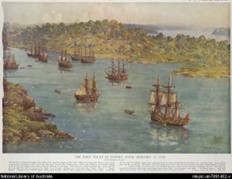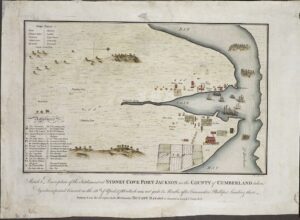As I write this, it is our National Day in Australia, where I live.
A local head teacher asked me to develop an interactive lesson to help her Primary school students understand what happened in January 1788. That was the time when a British colony was established, with about 1500 people arrived in 11 sailing boats from England.

I suggested a social-emotional re-enactment, where students could learn by playing the roles of those involved.
‘We only have fifty minutes for the class. Can you do it in that time?’ asked the teacher.
Having designed many interactive learning experiences, I reassured her it could be done.
I drafted and showed her the plan, which was agreed. I then coordinated the lesson and you can view some of the footage further below. We used the following timetable:-
Introduction – 5 mins – Tutor outlines to the students that 11 sailing boats, known as the ‘First Fleet’ transported about 1500 people from England to New South Wales. They established a colony on 26th January 1788 that eventually became the country we now know as Australia.
Video – 5 mins – Presentation of a short video showing the route, and type of old sailing ships that carried colonists across 10,000 miles of wild ocean waves for 252 days. The video indicates that half the colonists were deemed to be convicts, who were alleged to have broken the law.
Exercise Outline – 5 mins – All students were asked to meet in duos, and imagine they were colonists. They could choose if they wanted to be convicts, sailors, military marines or administrators. They were given the following exercise:-
Discussion – 15 mins – The students shared views, and wrote notes on topics such as the voyage, the weather, the animals in the new land, the native inhabitants of New South Wales and other issues
Presentations – 10 mins – The students read out their letters to the whole class.
Review – 10 minutes – The tutor summarized the main points, and also indicated issues arising for the indigenous tribal people, and how the New South Wales colonists developed a community and successful economy.
Drama Application
The following brief video shows how the students in another class engaged with the resources as part of their drama and dance education. Again, there was high engagement and the subsequent discussion shows that the students gained a lot from their experiential learning involvement.
By participating in the re-enactment of 26th January 1788, students gained an understanding of why Australia Day is commemorated.
They also learned about the national anthem, which is called ‘Advance Australia Fair.’
After the class, there was a buzz of conversation.
Students indicated they enjoyed participating. Comments included:-
‘It was interesting to understand why we have a National Day.’
‘It made us think about what is was like to be here in 1788 when there were no houses, no phones, no computer or TVs.’
In a Primary school class, we created a lesson that students would remember because they participated.
The social emotional involvement in playing the roles of colonists encouraged discussion. The letter writing exercise supported the creative expression of the students.

The lesson covered issues of history, geography, social studies and cultural understanding. The students also developed their ability to communicate their thoughts and ideas.
The foundation was the 5- minute video. That is a central aspect to the experiential learning approach to support re-enactment and learning.
We are now extending this to other topics. It is a powerful way to link virtual reality to the reality of learning by role playing reenactment.



